Sweat equity on the part of Long Beach Animal Care Services (ACS) was filtered to the shelter’s animals in the form of a record year for adoption, owner return and transport to other shelters. Even more heartening for animal advocates, volunteers and the dedicated shelter staff is an all-time low for euthanasia. The number is nearly half of what it was last year and over a third of what it was 2005.
“And I still have most of my hair,” said Shelter Manager Ted Stevens at the January 18 Open House of his four years of tireless and tiring job of heading off negative outcomes and meeting challenges head on with innovative programs and tactics.
ACS plans its Open Houses to provide a report card to the community about the previous year’s progress and discuss priorities for the year to come. The 2015 live release and euthanasia statistics point to a GPA that’s only a few percentage points from 4.0.
Stats Going in the Right Direction
Since 2011, the year before Stevens took the helm, combined impound rates of dogs and cats have decreased steadily and sharply between 2014 and 2015, with a decline of nearly 1,000 animals.
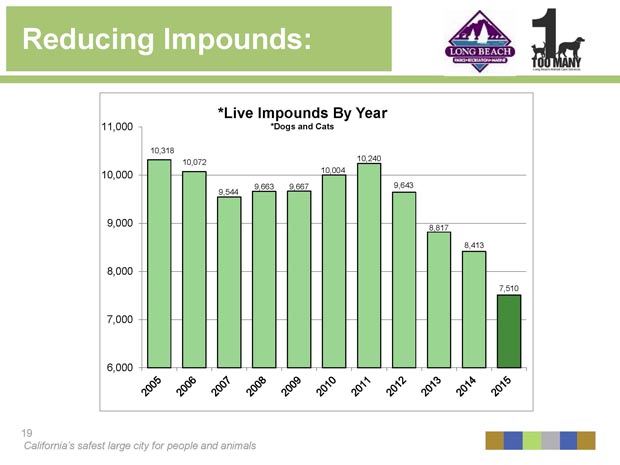
All statistics graphics courtesy of ACS.
Live release, which includes adoptions, owner return, rescue pulls, and transport to ASPCA-approved shelters where there’s a demand for certain types of animals, has had a near-steady increase from 2011, resulting in a 50 percent change. In total, there were 889 live releases of cats and 673 of dogs, not counting spcaLA pulls.
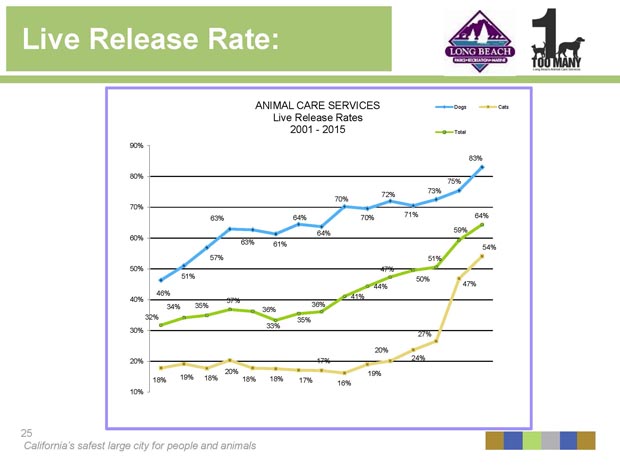
Euthanasia rates, which are scrutinized by every faction of the animal community, were the most impressive—having to kill a healthy pet for lack of resources is a source of both contention and heartbreak for not only animal-welfare groups but also shelter staff and volunteers. The numbers hovered from over 6,000 to over 5,000 from 2005 to 2012 and then began to fall, with sharp annual drops from 2013 to 2015. Last year’s euthanasia rate was at an all-time low at 2,379—over 3,000 fewer cats and nearly 1,000 fewer dogs.

“That didn’t happen by accident,” Stevens said, referring to the shelter’s partners, projects and community. “It’s better mentally for the staff. Now, we go a lot of days without euthanizing, whereas before, it was every day. We have plenty of space and no issues.”
Even with these numbers, Stevens still isn’t satisfied with the number of healthy pets still euthanized and plans to increase shelter efforts to reduce them further.
Community Cats
Stevens said that the shelter plans to shift the pendulum toward positive outcomes for cats this year and bring them up with those of dogs. Stray Cat Alliance (SCA) Executive Director Christ Metropole and Anna Wong, Long Beach’s Community Cat Lead, have been instrumental in this effort and will continue to be. Metropole was awarded this year’s 1 Too Many Award at the Open House for the work that her organization has done for community cats, which include any cat that’s free roaming, whether feral, abandoned, or fed outdoors by one or more people.
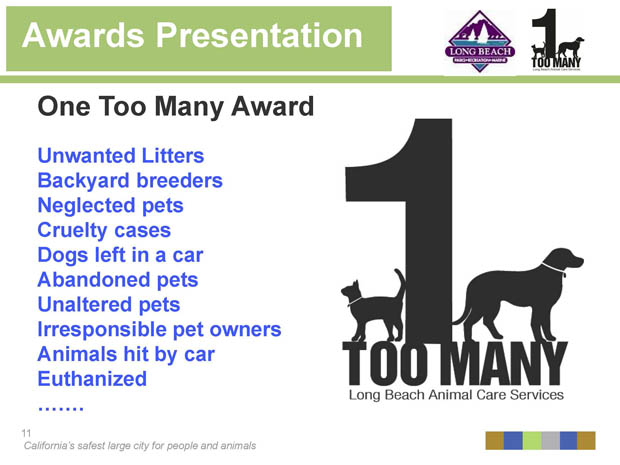
Image courtesy of ACS.
The award is the shelter’s highest honor, given to the community member who has contributed the most to animal well-being and welfare. Wong accepted the award for Metropole, who was running late.
“We started with [SCA] two years ago,” Stevens said. “They help pull friendly cats and get them adopted, and when there are community cat problems, they come out. This helps us with our workload, it helps with the officers. Anna goes above and beyond—she lives here and cares about the community.”
Wong said that she and Metropole are planning to fix 1,000 area cats before kitten season, which is the time when the shelters overflow with feline mamas and babies and many don’t make it out. She spoke for herself and Metropole when she picked up her award.
“I don’t think there’s any higher recognition—Christi and I are so excited!” she said. “This is not an award for Stray Cat Alliance. Every person in this room has a part in making this organization successful. Thank you for changing the scope about how cats are looked at. We are going to make Long Beach no kill because we are going to do it, not because someone told us to!”
Photo by Kate Karp.
Shelter Partners
Stevens highlighted other partners and projects that have helped with positive outcomes. spcaLA shares the P. D. Pitchford Companion Animal Village site at 7700 East Spring Street and has been a strategic partner with the shelter since the Village opened in August 2001. Denise Jakcsy, spcaLA’s Senior Director, said that spcaLA has pulled, fostered and adopted over 2,000 animals last year, allowing the shelter to focus on animals that need extra care or are hard to place and freeing up shelter resources to handle neglect and cruelty cases. The two entities also coordinately scheduled several family-oriented adoption events, including the Intergalactic Open House, a Star Wars-themed gala that had a line around the corner of hopeful attendees.
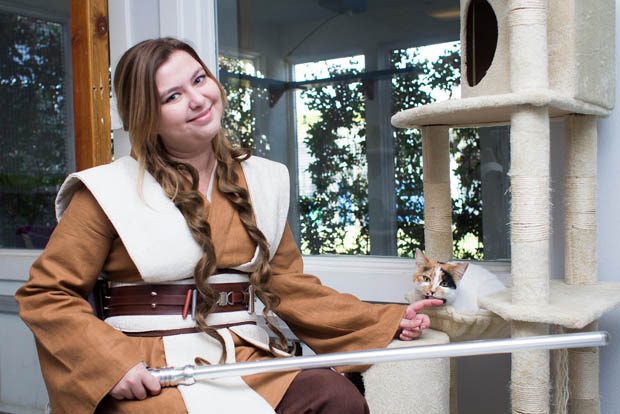
“May the Furs be with you.” Ren plays with her favorite Wookie at the Intergalactic Open House at P. D. Pitchford. Photo courtesy of spcaLA.
“Our staffs work very well together—we all have the same mission,” Jakcsy said.
Friends of Long Beach Animals (FOLBA) is Long Beach’s most venerable animal-welfare organization. They’ve partnered with ACS for over two decades, funding shelter goodies like Kuranda pet beds, staff training, leashes and humane education in the schools, including educational coloring books. More importantly, SNIP (Spay/Neuter Incentive Program) has provided over 11,000 low-cost spay/neuter vouchers for the pets of low-income families since 1998 and has funded the construction of a new clinic on the shelter grounds. The clinic, scheduled to open this year, will serve the veterinary staff on weekdays—they presently perform procedures in what amounts to a closet—and will be used for low-cost spay/neuter for the public on weekends.
Fix Long Beach (FLB), the recipient of last year’s 1 Too Many Award, has been a partner since its founding in June 2013. Stevens admitted that he was at first skeptical of founder Claudia Hoffman’s campaign to provide free spay/neuter procedures via mobile clinics for Long Beach’s low-income residents, but he says he’s now thoroughly convinced of its success. Since 2013, FLB has spayed and neutered over 4,000 pets, 1,044 of them this year. The mobile clinics and procedures themselves are funded privately by Hope for Paws; ACS provides microchips that are free to all of FLB’s clients and also gives vouchers for people who couldn’t get their pets into the clinic because of high demand.
‘Bone’ Voyage!
This year, ACS and its partners also helped transport over 300 cats and dogs to selected shelters throughout the United States, including Alaska, as well as Canada.
“Apparently, they needed pit bulls in Canada,” Stevens said. “It puts our mind at ease that ASPCA and not some flyby organization is handling this.”
ASPCA Relocation Director Lance Hunter detailed how pets are transported to areas where there’s a shortage of certain animals. The program has been successful enough for ASPCA to find it necessary to acquire more transport vehicles, Hunter said. He and his team received a Recognition Award from the shelter.
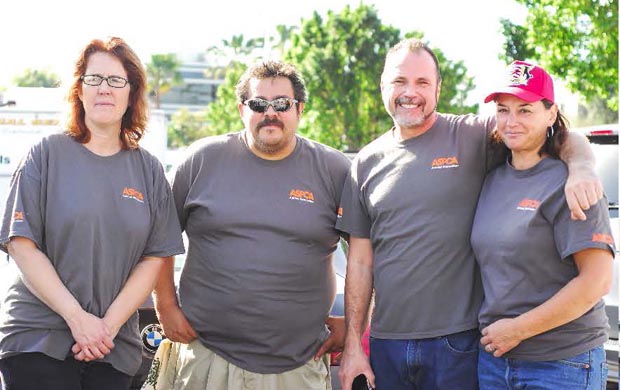
ASPCA transport team, with Lance Hunter (third from left). Photo courtesy of ACS.
Out of the Rabbit Hole
ACS gave another recognition award to Valerie Garcia, founder of the Sweetpea Foundation rabbit rescue in Whitter.
“Unfortunately in the past, rabbits were sort of an afterthought,” Stevens said. “So we really made an investment in them—The Bunny Barn. I’m happy to report that not one rabbit was euthanized for time and space. We don’t turn our backs on any critters that walk through the door—lizards, chickens—and it’s so nice not to have these wonderful pets sitting in the corner somewhere.”
Stevens said that since The Bunny Barn made rabbits more visible, it was often empty, and rabbits needed to be brought in from other shelters.
“We’re usually the ones sending cats and dogs—now here we are, paying it forward. Valerie did so much behind the scenes,” he said.
“I wish that other shelters could learn from this one. This is the best shelter I’ve ever worked with,” Garcia said.
Left: Valerie Garcia hops to it regularly to help find homes for rabbits. Photograph by Kate Karp.
You’ve Got a Friend
The Spirit of Dr. Loren Eslinger Award is named for the late veterinarian who donated her time to the shelter’s animals as a labor of love. The award is given to ACS’s volunteer of the year, and Douglass Pennington received it this year. Pennington’s resemblance to Santa Claus doesn’t stop at his beard and friendly demeanor; Stevens cited many hours he spends interacting with pets in need or crisis, such as Tiny Tim, a Chihuahua who had been found by a group of youngsters as he was roaming near the traffic circle with an old injury.
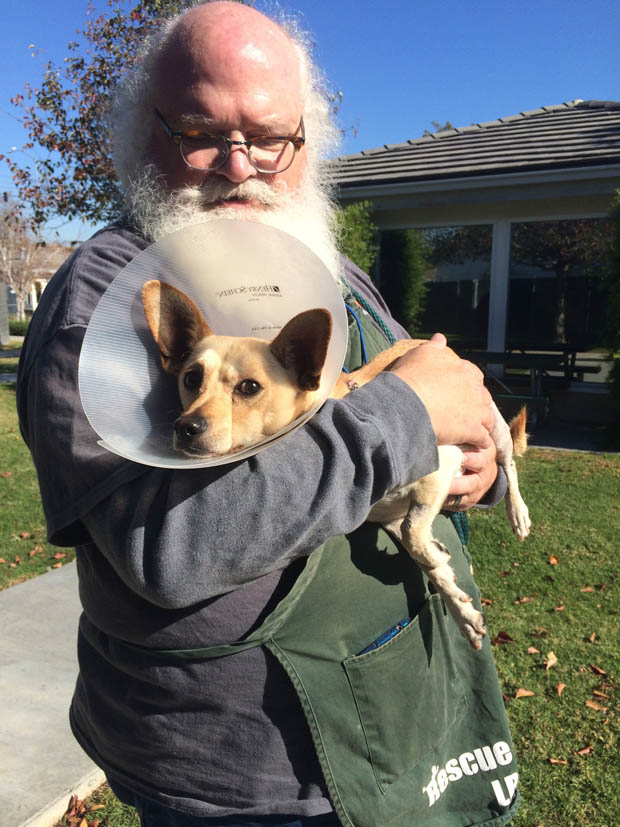
Doug has seen to it that Tiny Tim fot whatever he wants on his holiday list. Photo courtesy of ACS staff.
“We have so many great volunteers, and this person came up right away,” Stevens said. “We can call him on speed dial, and he’s a yes man. It really is helpful when we have a surgery in downtown L.A. and we say Doug, do you mind sitting in traffic for three hours? He continues to be the Freedom Ride for pets. He’s here four in the morning, five in the morning to fulfill that process. He also assists in training with rescue partners. He’s polite, respectful and always has a cheerful attitude.”
Volunteers: The Shelter’s Lifeblood
Along with a hardworking staff, to which ACS has this year added an adoption coordinator, volunteers are the lifeblood of the shelter. They clean pet areas, participate in transports, assist with adoption, foster pets, participate in the Explorer Academy at the shelters, do internships, and perform countless other tasks. Volunteering at ACS ha become so specialized that the shelter hired a volunteer coordinator for management in 2014. And last year, some of the volunteers took on other volunteers to establish the Animal Rescue Team (ART) table in front of the shelter to suggest alternatives to people who have come to surrender their pets.
ART table volunteers outside shelter door. Photos, including those above, by Kate Karp.
Root of the Problem Addressed
Last year, the Long Beach City Council, with ACS’s input, passed the Mandatory Spay/Neuter and Pet Shop ordinances, which went into effect in October. The wording mandates that all dogs, with some exceptions, must be spayed or neutered (it has been illegal to own an unaltered cat for several years) and no animal may be sold publicly or privately unless through a licensed breeder or in businesses where shelter/rescue pets are up for adoption.
Adoption galas included Mayor Robert Garcia’s Kitty Hall, at which every pet was adopted, and shelter staff members were included in the mayor’s holiday card.
“I am proud of the Long Beach community for stepping up to support our local shelter,” Mayor Garcia said. “Through community engagement and partnerships with nonprofit groups, we’ve been able to reduce animal overpopulation and give more pets a loving, permanent home. There’s more work to do, but I’m proud of the progress.”
A Banner Year, but No Coasting Allowed
The coyote plan was also revised, and an interactive map was added to the page at the shelter. New social media for finding lost pets and reporting found ones were welcome innovations; the Twitter tag #LBLostFoundPets has been effective in this respect. Other accomplishments include the sponsorship of 1,000 low-cost clinics at 20 locations around Long Beach; garnering over 7,300 Facebook followers and almost 1,000 on Instagram, both of which feature adoptable pets; and addition of four languages—Khmer, Tagalog, English and Spanish—to the shelter’s mobile app and phone system.
“I’m sure I’ve forgotten something,” Stevens said.
Shelter staff also did what shelter staff typically does: completed over 26,000 field-activities in the shelter’s jurisdiction (Long Beach, Seal Beach, Los Alamitos, Signal Hill and Cerritos); took part in vicious animal hearings and felony cruelty cases; responded to calls; handled public-safety issues and wildlife in danger; performed veterinary procedures seven days a week; managed $1 million in license revenues; and handled the office telephones.
“Working in that front office is the most difficult,” Stevens said. He invited the audience to hang out there and see for themselves.
Stevens mapped out plans for 2016: the new FOLBA-funded clinic; improving response time to calls; greater live-release numbers and lower impounds and euthanasia; increased community outreach; more offsite adoptions, including at Pet Food Express’s new Long Beach location; more free and low-cost spay/neuter clinics; and improved shelter environment for guests animal and human. This will include play groups for the animals and a privately funded open cat room.
ACS Rescue and Transport Coordinator Sara Cozolino, Adoption Coordinator Jill Prout, and Outreach Coordinator Kelly Miott team up to spotlight shelter pets. Here they are with the very adoptable Tigger, who was recently pulled by a rescue. Photo by Kate Karp.
“Looking forward, we’re not satisfied by any means,” Stevens said. “We’re headed in the right direction but still have some work to do. And we’re going to continue to work toward making these numbers even better.”
Even if you can’t come to the shelter, there are a lot of ways that you can help insure positive outcomes for our shelter pets. Contact ACS’s volunteer coordinator at Kathy.Roddy@LongBeach.gov. For more information, call 562.570.7387.
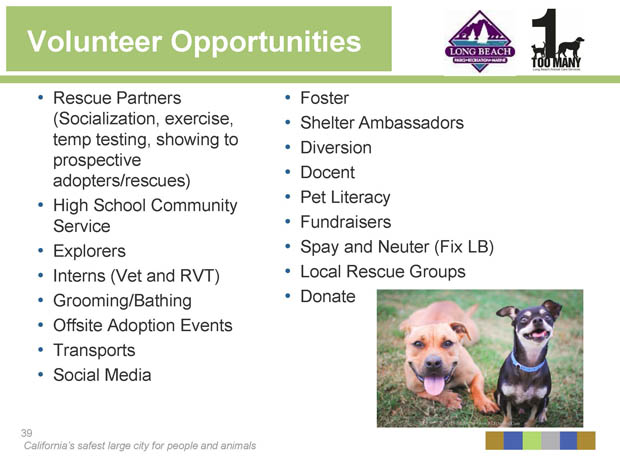
Rome wasn’t built in a day, but they were laying bricks every hour.
~ James Clear, entrepreneur, weightlifter and travel photographer

